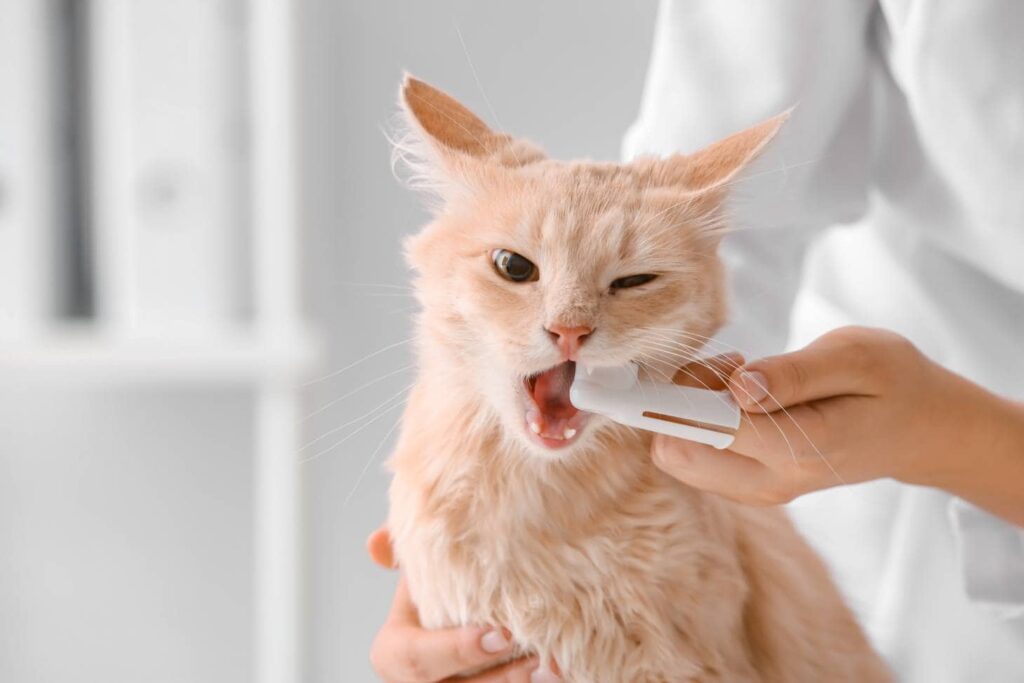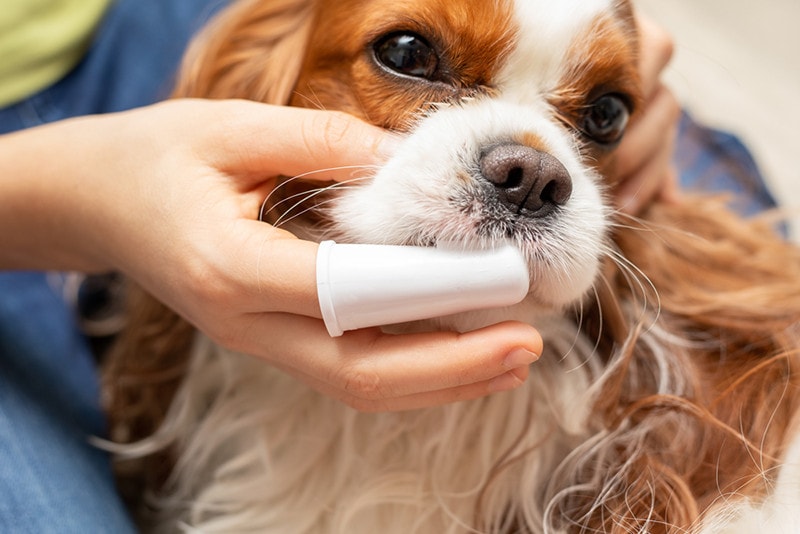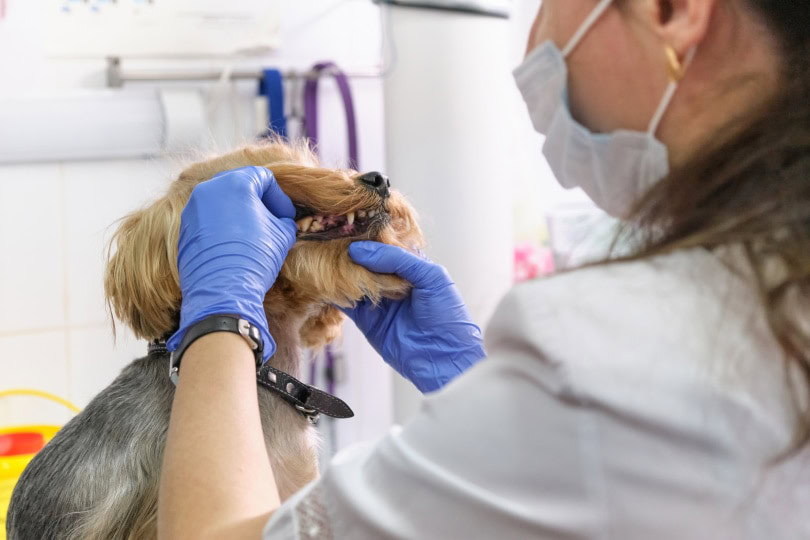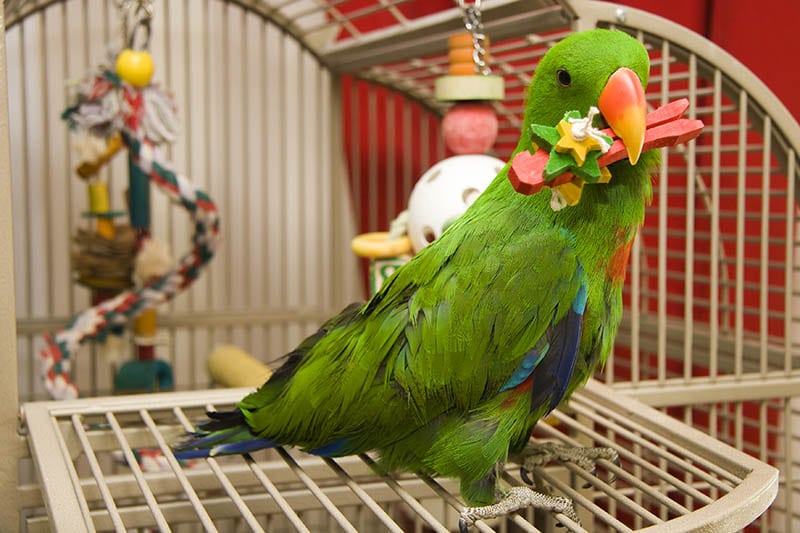VET APPROVED

The information is current and up-to-date in accordance with the latest veterinarian research.
Learn more »Click to Skip Ahead
February is National Pet Dental Health Month in the United States. But what is it exactly? Well, it’s a month dedicated to raising awareness about the importance of dental health in pets and how to recognize dental disease. The American Veterinary Medical Association (AVMA) started this initiative to encourage pet owners to take care of their pets’ teeth and gums. During this month, many veterinary clinics offer dental exams, cleanings, and discounts on dental products, making it easier for pet owners to take action towards improving their pet’s oral health.
Sometimes, pet dental health is overlooked, and many pet owners are not aware of how crucial it is for their pet’s overall well-being. Just like humans, pets can suffer from dental problems such as bad breath (halitosis), gum disease, and even bone loss. These problems can be very painful and lead to more severe health issues if left untreated. Let’s learn more about the importance of pet dental health and what you can do year-round for your pet.

The Importance of Pet Dental Health
Dental health is an essential aspect of pet health. Poor dental hygiene can lead to a build-up of plaque and tartar (or calculus) on your pet’s teeth, which can cause gum disease, tooth decay, and bad breath. Additionally, bacteria from the mouth can travel through the bloodstream and cause infections in other parts of the body, such as the heart and kidneys.
Regular dental care can help prevent these problems from developing and keep your pet’s teeth and gums healthy. A healthy mouth can also improve your pet’s quality of life by making it easier for them to eat, play, and socialize without any discomfort.

Common Dental Problems in Pets
Pets can suffer from various dental problems. Here are some of the most common dental issues pets can face.
- Plaque and tartar buildup: Plaque is a sticky, whitish film of bacteria, saliva, and food debris that forms on teeth. If not removed within 24 hours, it hardens into tartar—a yellowish-brown deposit you may notice on your pet’s teeth and along the gumline. This buildup can lead to inflammation and infection of the tissues that support the teeth (periodontal disease).
- Gingivitis: Gingivitis is the earliest stage of periodontal disease and is reversible. It presents as red, swollen, and sometimes bleeding gums. If addressed promptly with proper dental care, the prognosis for recovery is excellent.
- Periodontitis: If gingivitis is not treated, periodontitis develops. It is an irreversible inflammation of the deeper tissues that support teeth: the periodontal ligament, cementum, and alveolar bone. Preventive care is crucial to avoid reaching this stage.
- Tooth decay (or caries): Tooth decay occurs when bacteria in the mouth produce acid that erodes the enamel on teeth. This can lead to cavities and tooth loss.
- Bad breath (Halitosis): Bad breath in pets is not normal. It’s often an early sign of dental disease or other underlying health issues and should always be investigated.
Signs That Your Pet May Have Dental Issues
Pets can’t tell us when they’re experiencing dental pain or discomfort, so it’s important to be aware of the signs that your pet may have dental issues.
- Bad breath
- Drooling
- Loss of appetite or difficulty chewing and eating
- Dropping food
- Pawing at the mouth or face
- Bleeding or swollen gums
- Missing teeth
- Discoloured teeth
If you notice any of these signs, it’s essential to take your pet to a vet for a dental exam. There are some pet insurance plans that include dental care, or you can get dental insurance for your pet alone.
Preventative Measures for Pet Dental Health
Prevention is key when it comes to pet dental health. Luckily, however, there are several preventative measures you can take to keep your pet’s teeth and gums healthy. So here are some of the best ways to help prevent your pet from having dental issues.
- Regular brushing: Brushing your pet’s teeth daily is the most effective way to remove plaque and prevent dental problems. Aim to brush your pet’s teeth at least once a day with a pet-specific toothbrush and toothpaste.
- Regular vet check-ups: Regular dental exams by your vet (at least once a year) can help identify and treat dental problems early on and can prevent them from becoming even bigger problems.
- Dental diets: Some pet foods are specially formulated to promote dental health by reducing plaque and tartar buildup.
- Dental chews and toys: Chewing on dental chews and toys can help remove plaque and promote gum health.

Tips for Brushing Your Pet’s Teeth
Brushing your pet’s teeth may seem like a daunting task, but with the right tools and techniques, it can be a breeze. Here are some tips to help you brush your pet’s teeth effectively.
Choose the Right Products
First, choose the right toothbrush and toothpaste for your pet. You can use a soft-bristled toothbrush or a finger brush to clean your pet’s teeth. It’s important to use toothpaste specifically designed for pets as human toothpaste can be harmful to them. You can find pet toothpaste in various flavors, such as chicken or beef, which can make the brushing experience more pleasant for your pet.

Start Slow
Next, introduce the toothbrush and toothpaste to your pet gradually. Start by letting them sniff and taste the toothpaste before putting it on the brush. Once they’re comfortable with the toothpaste, gently introduce the toothbrush and let them get used to the sensation of having it in their mouth.
When brushing your pet’s teeth, use gentle circular motions to clean the teeth and gums. Focus on the outer surfaces of the teeth, as these are the areas where plaque and tartar tend to accumulate. And note that pets may be wary of letting you brush the inside of their teeth, so be prepared for this. But as long as you’re able to get the outside of the teeth, it helps. Be sure to praise and reward your pet after each brushing session to encourage positive behavior.
Make It a Regular Thing
Get into the habit of brushing your pet’s teeth. Veterinarians recommend that pet owners brush their pets’ teeth at least once a day, but if that’s not possible, aim for at least four to five times a week. You’ll be surprised by how much a few minutes of brushing can help remove weeks of plaque and prevent gum disease and other issues from developing.


How to Choose the Right Dental Chews and Treats for Pets
Pet owners always want the best for their furry friends, and dental health is no exception. Dental chews and treats are a popular choice for pet owners looking to improve their pet’s oral hygiene. However, not all dental chews and treats are created equal. With so many options available, it can be sort of overwhelming to choose the right one for your pet. Here are some tips to help you make the decision easier.
Ask Your Vet
First, try asking your vet about treats for dental health. They can provide recommendations based on your pet’s specific needs and health concerns. For example, if your pet has sensitive teeth or gums, your vet may recommend a softer chew. If your pet is prone to digestive issues, they may advise against certain ingredients.

Find VOHC-Approved Products
Next, look for dental chews and treats that have the Veterinary Oral Health Council (VOHC) seal of approval. The VOHC is an independent organization that evaluates products for their effectiveness in reducing plaque and tartar buildup. Products with the VOHC seal have undergone rigorous testing and are backed by scientific evidence.
Consider Treat Size, Texture & Calories
First, consider the size and texture of the dental chew or treat. It should be appropriately sized for your pet, so they can chew it comfortably and safely. The texture should be firm enough to clean their teeth, but not so hard that it can damage their teeth or cause choking. Secondly, check the calories per treat and factor them into your pet’s total daily calorie intake—remember that treats should make up no more than 10% of their overall diet.

Observe Your Pet
Finally, observe your pet’s behavior when giving them dental chews and treats. If they are unable to chew it properly, it may not be the right product for them. Additionally, if they experience any adverse reactions, such as vomiting or diarrhea, discontinue use immediately and consult with your veterinarian.

Wrapping Things Up
February is National Pet Dental Health Month, but dental care should be a year-round priority for pet owners. By taking preventative measures such as regular brushing, dental chews, and veterinary check-ups, you can help keep your pet’s teeth and gums healthy and prevent dental problems.
Remember that a little bit of maintenance can go a long way in terms of preventing some pretty serious dental issues that your pet can develop. With a little bit of effort and knowledge, you can give your furry friend the gift of a healthy smile.
Related Reads:
- Animal Pain Awareness Month: What It Is & When It’s Celebrated
- National Pet Insurance Month: When It Is & How to Observe
Featured Image Credit: Happy monkey, Shutterstock










